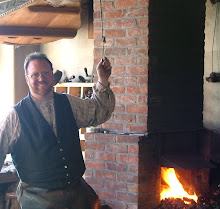They used a category of simple tools for the bench and anvil that were easy to make, quick to use, and that held their work still in one dimension. These were called hold-fasts and bench dogs. A hold-fast looks like an iron letter 7. It is dropped in a hole in the bench or the anvil. The jaw is placed upon the work and the body is struck with a mallet. That drives the upright into the bench hole, compresses the natural spring of the tool, and holds your work to the anvil or bench.


A bench dog is a little different. It is a metal post with a lip that is set into a square hole in the carpenter’s bench. The wood being worked is then pushed against the bench dog while it is being planed, carved, or otherwise worked. The bench dog can be used in cooperation with a Vice-dog to clamp a board in place for working as well.


Any tool that held something by grabbing it in a jaw tended to be called a “Dog” in the 19th century. There were bench dogs, log dogs, and saw mill dogs. Something held securely was “dogged down”. These simple tools do not have the perfect hold of a modern vice. They were however simple enough for a village blacksmith shop to produce, and made a craftsman’s life easier.

No comments:
Post a Comment